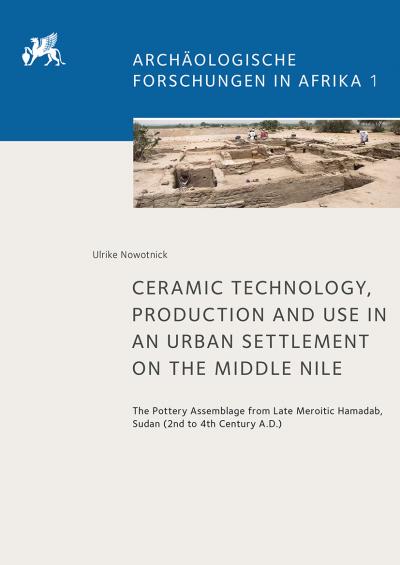Ceramic Technology, Production and Use in an Urban Settlement on the Middle Nile : The Pottery Assemblage from Late Meroitic Hamadab, Sudan (2nd to 4th Century A.D.)
https://doi.org/10.34780/18dd-46z1
##submission.synopsis##
Excavations in the ancient town of Hamadab (Sudan) have revealed a large urban settlement of the 3rd century B.C. to 4th century A.D. – a once thriving neighbour to Meroe, the capital of Kush. As one of the few well-researched habitation sites in the region, Hamadab has revealed new insights on the way of life in a past African community about 2000 years ago. Archaeological investigations in the town, and particularly of pottery kilns and domestic houses, yielded large quantities of ceramics which provide important categories of data suitable for exploring the role of pottery in craft production and everyday life. They form the basis for an empirical analysis of production technologies and ceramic use; research topics that remain little studied in the archaeology of the Middle Nile region. By evaluating a large ceramic corpus from Hamadab, this book defines, for the first time, a Late Meroitic domestic assemblage. Kiln remains and household ceramics were analysed towards the economic and domestic activities in a Kushite settlement, using the broad potentials of ceramic analysis, such as archaeometric fabric analyses, contextual approaches, use wear traces and ethnoarchaeological observations. The evaluation of scientifically defined fabric groups also incorporates ceramics from the excavations at the Royal Baths in Meroe, which allows for a wider spectrum in studying the changes in Kushite ceramic technology, raw material selection and clay preparation. This book thus provides an important methodological and thematic reference for a Meroitic living assemblage and the analytical basis for understanding wider socio-cultural phenomena in the region.
الكلمات المفتاحية:
Meroe, Kush, household archaeology, pottery analysis, material culture##submission.chapters##
-
Vorwort der Herausgeber
-
Preface and Acknowledgements of the Author
-
1 Introduction
-
1.1 Prologue
-
1.2 Cultural Background
-
1.3 Research Area
-
1.4 Research Period
-
1.5 Previous Research on Domestic Ceramics of the Meroe Region
-
1.6 Research Objectives
-
2 Materials and Methods
-
2.1 Material Basis from Recent Excavations
-
2.2 Scope of the Study
-
2.3 The Examined Ceramic Corpus
-
2.4 The Recording System
-
2.5 The General Character of the Hamadab Assemblage
-
3 The Chaîne Opératoire in Kushite Ceramic Manufacture
-
3.1 Raw Material Procurement in the Meroe Region
-
3.2 Clay Preparation
-
3.3 Shaping
-
3.4 Finishing
-
3.5 Drying and Firing
-
4 Fabric Classification – Outline of the Scheme
-
4.1 Previous Research
-
4.2 Research Questions
-
4.3 Sample Set
-
4.4 Analytical Approach
-
4.5 Results of Archaeometric Analyses
-
5 Fabric Evaluation – Application of the Scheme
-
5.1 Macroscopic Fabric Examination
-
5.2 Nile Clay
-
5.3 Wadi Clays
-
5.4 A Note on Mixed Clays
-
5.5 Kaolinitic Clays
-
5.6 Marl Clays
-
5.7 Non-Local Clays for Specific Ceramic Types
-
5.8 Conclusions on Raw Material Use in Kushite Times
-
6 The Kiln Pottery – Urban Ceramic Production
-
6.1 Contextual Information and Recording Strategies
-
6.2 Kiln Yard Assemblage
-
6.3 Analysis of the Kiln Load
-
6.4 Interpretation of an Urban Craft Production
-
7 Domestic Ceramics from a Late Meroitic House
-
7.1 Research Questions
-
7.2 Contextual Information on House H 1600
-
7.3 Household Inventory
-
7.4 Functional Ceramic Types for Domestic Practices in Meroitic Times
-
7.5 Reconstructing Household Activity Patterns
-
8 Conclusions
-
8.1 Consumer Market – Patterns of Ceramic Production and Consumption
-
8.2 Craftsmen, Priests or Unfree Subjects? – The Question of Identity
-
8.3 Upper-, Middle- or Lower-Class Folk? – The Question of Status
-
8.4 Hamadab’s Place in the Regional Context of the Middle Nile Valley
-
9 Appendices
-
9.1 Appendix A – Fabric Sample Catalogue
-
9.2 Appendix B – Register of Illustrated Ceramics
-
Abbreviations and Arabic Terms
-
Bibliography
-
Sources of Illustrations
-
Plates 1–70
-
Photo Plates 1–4




